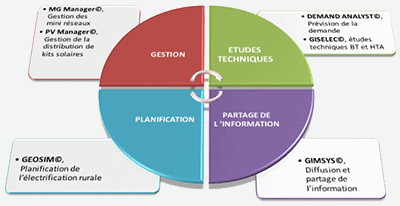GISELEC - Design and optimisation of distribution network

In the actual environment where companies and institutions in charge of electrification are looking to cut costs, it has become essential to identify low cost solutions in terms of technology but also to optimize the design of power lines for distribution energy especially in rural and remote areas where electrification remains a loss making activity. It is therefore necessary to first optimize the medium and low voltage networks starting from feasibility studies, avoiding additional costs due to oversizing of equipment to be installed.
GISELEC© is a user-friendly software accessible to all, built on the Geographic Information Systems (GIS) technology which has the objective of streamlining the design of electrical lines by:
- Helping to optimize sizing and location of transformers within villages by mapping and forecasting load points previously identified during the village mapping steps
- Optimization of cable cross sections for medium and low voltage lines according to load forecast criteria in rural electrification projects (network expansion or decentralized networks projects)
- Supporting electrical engineers for technical decisions during electrical and mechanical network studies...
Optimize distribution networks sizing so as to reduce Infrastructures investment thanks to Geographic Information Systems
- Analysis of energy demand (consumption and peak energy demand) for a specific village in short, medium and long terms according to the load forecast module previously customized, in order to estimate the number and capacity of each planned transformers.
- Placement of transformers optimisation near the energy loads centroid so as to reduce energy losses and voltage drops.
- Calculation of energy losses and voltage drops and identification of critical cables cross section for planned networks.
- Optimisation of cable cross sections based on the power supplied by the network and according to the list of cables available in the study area.
- Poles localization, mechanical calculation, editing bill of quantities and detail design study.
- Editing reports and maps related to the grid sizing mapping and calculation of coverage ratio within the studied area.
GISELEC TRANSFO
Module for transformers sizing and positionning
Because optimizing a network means finding the most suitable place for transformers setting-up, which will supply energy to a locality and its whereabouts so as to reduce losses according to the energy loads distribution. This module will particularly help users to:
- Localize the best place to install transformer according to energy loads distribution (households, socio and economic activities…) within the targeted area.
- estimate transformers capacity thanks to the powerful load forecasting model integrated to GISELEC© et visualize transformer coverage area.
GISELEC DISTRIB
Module for sizing low voltage (LV) lines
Reducing distribution costs by optimizing network design and least cost grid sizing. From a village cartography geo-referencing energy loads within the study area and a proposed network design, GISELEC DISTRIB will analyse the LV grid in order to :
- Optimize cable cross sections of the low voltage lines and identify critical sections along the network
- Evaluate voltage drops in various locations along the network, provide estimates of electric losses and validate electric network feasibility
- Propose a least cost solution for developing the LV network
- Map the new sized network
GISELEC CONNECT
Module for sizing medium voltage (MV) lines
Similar to LV lines study, GISELEC CONNECT analyse MV network connecting transformers identified in the GISELEC DISTRIB module or villages within a specific area in order to optimize the MV grid network. The module will therefore:
- Optimize cable cross sections of the medium voltage lines and identify critical sections along the network
- Evaluate voltage drops in various locations along the network, provide estimates of electric losses and validate electric network feasibility
- Propose a network least cost solution for developing the MV network
- Map the new sized network.
GISELEC MECA
Module for network mechanical calculation
GISELEC MECA allows, from a planned distribution network, to place and size automatically poles available within an equipment catalogue defined for the project, based on mechanical forces involved all along the network. Finally, this module help to :
- Compare various technical solutions (equipment, span length, railing height..)
- Determine bill of quantities for the preparation of call for proposal (supports, cross arms, cables…)
- Edit network design...
Minimal configuration
- GIS software Manifold© compatible MAPINFO, ESRI, AUTOCAD, QGIS…
- Windows 7, 10, 11
- Plateform .NET 4.6
- Compatible Geosim, NAP et Camelia
- MS Excel 2007 minimum
Software deployed in many utilities and consulting companies in:
Benin, Senegal, Burkina Faso, Cameroon, DRC, Madagascar, Burundi...Purchase and Maintenance
Please contact us here for any quotation request or proforma
You must connect to your personal account or create a new one to access to maintenance subscriptions -> Click here

















